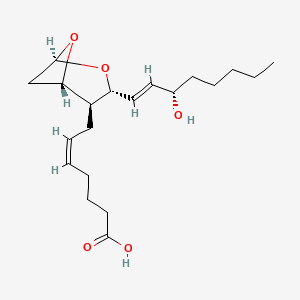
|
Thromboxane a2 |
Thromboxane a2 is a lipid of Fatty Acyls (FA) class. Thromboxane a2 is associated with abnormalities such as Asthma, Cardiovascular Diseases, Pulmonary Eosinophilia, ASPIRIN SENSITIVITY and Pneumonia. The involved functions are known as Signal Transduction, paracrine, Binding (Molecular Function), Platelet Activation and Inflammation. Thromboxane a2 often locates in Cell surface, Body tissue, Cell membrane, Blood and Extracellular. The associated genes with Thromboxane a2 are PTPRC gene, ESAM gene and PPBP gene. |
4534 |
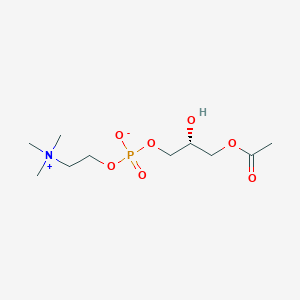
|
Lysophosphatidylcholine |
Lysophosphatidylcholine is a lipid of Glycerophospholipids (GP) class. Lysophosphatidylcholine is associated with abnormalities such as Ischemia, Obesity, Diabetes Mellitus, Non-Insulin-Dependent, Fatty Liver and Atherosclerosis. The involved functions are known as Inflammation, antagonists, Signal Transduction, Signal Pathways and Saturated. Lysophosphatidylcholine often locates in Body tissue, Head, integral to membrane, Membrane and Extracellular. The associated genes with Lysophosphatidylcholine are RHOA gene, Homologous Gene, GPR4 gene, GPR68 gene and TRPV2 gene. The related lipids are Nonesterified Fatty Acids, lysophosphatidylethanolamine, Lysophosphatidylcholines, Phosphatidylserines and 25-hydroxycholesterol. The related experimental models are Knock-out and Disease model. |
4395 |

|
6-aminohexanoic acid |
6-aminohexanoic acid is a lipid of Fatty Acyls (FA) class. 6-aminohexanoic acid is associated with abnormalities such as Blood Clot, Myocardial Infarction, Cerebrovascular accident, Renal impairment and Scoliosis, unspecified. The involved functions are known as Fibrinolysis, Agent, Hemorrhage, plasminogen activation and inhibitors. 6-aminohexanoic acid often locates in Chest, Blood, Body tissue, peritoneal and Plasma membrane. The associated genes with 6-aminohexanoic acid are P4HTM gene, BSND gene, MTPN gene, NDUFS4 gene and Homologous Gene. The related lipids are Phosphatidylserines and Butyric Acid. |
3685 |

|
Taurocholic acid |
Taurocholic acid is a lipid of Sterol Lipids (ST) class. Taurocholic acid is associated with abnormalities such as Cholestasis, Cholestatic liver disease, Exanthema, Hepatitis and Fibrosis, Liver. The involved functions are known as Uptake, Metabolic Inhibition, Drug Interactions, inhibitors and Excretory function. Taurocholic acid often locates in Hepatic, Plasma membrane, Blood, Membrane and Endothelium. The associated genes with Taurocholic acid are SLC10A1 gene, SLCO1B1 gene, SLC10A2 gene, P4HTM gene and Polypeptides. The related lipids are Steroids, Sterols, Lipopolysaccharides, 7-dehydrocholesterol and cholanic acid. |
3446 |
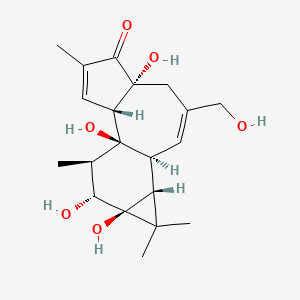
|
Phorbol |
Phorbol is a lipid of Prenol Lipids (PR) class. Phorbol is associated with abnormalities such as furuncle, Infection, endothelial dysfunction, Morphologically altered structure and Acute erythroleukemia. The involved functions are known as Tyrosine Phosphorylation, Metabolic Inhibition, Transcription, Genetic, Protein Biosynthesis and Signal. Phorbol often locates in Tissue membrane, Membrane, Cell surface, soluble and Cytoplasmic Domain. The associated genes with Phorbol are STAT3 gene, JAK2 gene, JUN gene, PROC gene and MAPK8 gene. The related lipids are Lipopolysaccharides, Phosphatidylserines, Liposomes, Fatty Acids and Octanols. |
2082 |

|
Sphingosine 1-phosphate |
Sphingosine 1-phosphate is a lipid of Sphingolipids (SP) class. Sphingosine 1-phosphate is associated with abnormalities such as Infection, Painful Bladder Syndrome, Atherosclerosis, Hyperglycemia and Rheumatoid Arthritis. The involved functions are known as Phosphorylation, Regulation, enzyme activity, Energy Absorption and Vascular Permeability. Sphingosine 1-phosphate often locates in Endothelium, Tissue membrane, Vascular System, Protoplasm and Microfilaments. The associated genes with Sphingosine 1-phosphate are MBTPS1 gene, FBXL15 gene, TEK gene, NTRK1 gene and Gene Family. The related lipids are Promega, Lipopolysaccharides, lysophosphatidic acid, Lysophosphatidylcholines and Lysophospholipids. The related experimental models are Knock-out, Mouse Model, Transgenic Model, Disease model and Experimental Autoimmune Encephalomyelitis. |
2005 |

|
emodin |
emodin is a lipid of Polyketides (PK) class. Emodin is associated with abnormalities such as Infection, Conjunctivitis, Vernal, Stevens-Johnson Syndrome, Conjunctival scar and Allergic Conjunctivitis. The involved functions are known as signaling cascade, Metabolic Inhibition, Cell Death, Phosphorylation and JNK Pathway. Emodin often locates in Membrane, Protoplasm, Mitochondria, Cytoplasmic matrix and soluble. The associated genes with emodin are cytochrome c'', UTS2 gene, TK Gene, Gene Clusters and CFC1 gene. The related lipids are Phosphatidylserines, Promega, Sphingolipids, Membrane Lipids and Palmitates. The related experimental models are Mouse Model and Transgenic Model. |
1742 |
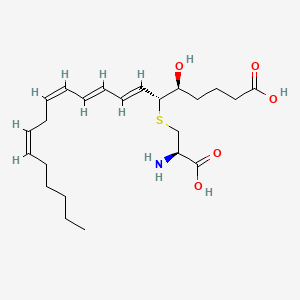
|
LTE4 |
Lte4 is a lipid of Fatty Acyls (FA) class. Lte4 is associated with abnormalities such as Asthma, Lung diseases, Eosinophilia, Respiration Disorders and Rhinitis. The involved functions are known as Anabolism, Increased Sensitivy, Process, Pathogenesis and Stimulus. Lte4 often locates in Membrane, Smooth muscle (tissue), Body tissue, Extracellular and Mucous Membrane. The associated genes with LTE4 are cystinylglycylglycine, FPR1 gene, PECAM1 gene, CCL3L1 gene and IL3 gene. |
1546 |
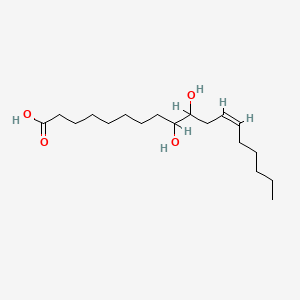
|
9,10-DiHOME |
9,10-dihome is a lipid of Fatty Acyls (FA) class. |
1159 |
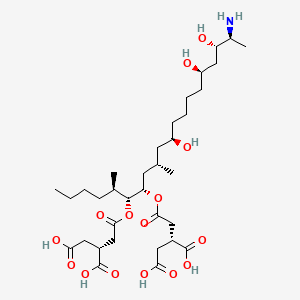
|
fumonisin b1 |
fumonisin b1 is a lipid of Sphingolipids (SP) class. Fumonisin b1 is associated with abnormalities such as Infection, Kidney Diseases, Liver diseases, DERMATITIS HERPETIFORMIS, FAMILIAL and Malnutrition. The involved functions are known as Gene Expression, Anabolism, Signal, Biosynthetic Pathways and Regulation. Fumonisin b1 often locates in Body tissue, Microsomes, microsomal membrane, Protoplasm and Mitochondria. The associated genes with fumonisin b1 are Genome, P4HTM gene, FATE1 gene, BCL2 gene and TMEM132D gene. The related lipids are dihydroceramide, ceramide 1-phosphate, Sphingolipids, Fatty Acids and Palmitates. |
902 |









